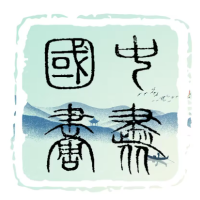画坛名家贾又福,静观之道大成也。生于辛巳年肃宁县,师承李可染、李苦禅、叶浅予、宗其香、何海霞诸师。其山水画分诗思抒发与哲思表达二类。贾氏静观,非仅目视,乃心灵静思。其艺贯感联至妙悟,领会周敦颐“动极而静,静极复动”,践“抚令思古”、“察古思今”之格物精神,达慧观智觉,启灵感明慧。
Master Jia Youfu, an eminent figure in the world of painting, has mastered the art of "quiet observation." Born in the year of Xin Si in Su County, he studied under renowned masters such as Li Keran, Li Kuchan, Ye Qianyu, Zong Qixiang, and He Haixia. His landscape paintings are divided into two categories: those that express poetic sentiments and those that convey philosophical thoughts. Jia's "quiet observation" involves not just visual perception but also deep mental contemplation. His art integrates feelings and insights, embodying the principles of Zhou Dunyi's "movement culminates in stillness, and stillness culminates in movement," and the spirit of exploring the past to understand the present, achieving wisdom and enlightenment through keen observation.
贾氏继承我国山水诗之传统。其太行山景,蕴诗兴、诗味、诗风、诗境。常化景为情,物我相融,成山水画诗化纯度。乙丑年中期,贾氏探索哲理山水画,以化心象为哲思,创意造境,重铸江山,再造自然。其第二自然样态与图式,表现山岳开阔、天地奇观、大化运行、宇宙精神,显原生、太朴、雄奇、博大、天籁、悲壮、崇高之美,震撼、鼓舞、超越、升华、净化观者心灵。
Jia Youfu has inherited the tradition of Chinese landscape poetry. His depictions of the Taihang Mountains are imbued with poetic inspiration, flavor, style, and ambiance. He often transforms scenery into emotions, blending the subjective and the objective, creating a poetic purity in landscape painting. In the mid-period of the year of Yi Chou, Jia began exploring philosophical landscape painting, transforming mental images into philosophical expressions, creating new realms, and reshaping nature. His second nature forms and compositions portray the vastness of mountains, the marvels of heaven and earth, the operation of grand natural forces, and the spirit of the cosmos, revealing the beauty of originality, simplicity, grandeur, vastness, natural harmony, tragic magnificence, and sublimity, profoundly impacting, inspiring, transcending, elevating, and purifying the viewer's soul.
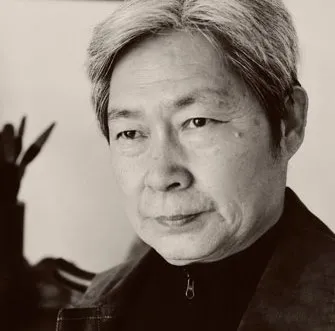

贾氏静观,精神升华之过程,亦生命境界之冲和。自由超越时空,昼夜室内外,始终静观。随时随地觉悟,如邵雍所言:“能知万物备于我,肯把三才别立根。”贾氏观万物,不限天地自然,亦涵社会人文,故其静观无穷尽,自“起观”始,延续不绝。
Jia's quiet observation is a process of spiritual elevation and a state of harmonious existence. He transcends time and space freely, engaging in continuous observation day and night, indoors and outdoors, always attaining enlightenment. As Shao Yong said, "One who knows that all things are within oneself can establish the foundation of the three talents." Jia observes all things, encompassing both nature and society, thus his quiet observation is endless, beginning from the initial observation and continuing without interruption.
贾氏创作,经历“按实肖像”与“凭虚构象”阶段。“按实肖像”如实描写,类对景写生,追求眼中视像;“凭虚构象”突破如实再现,以心灵表象自由组构为物证,表现心灵之境。二者相辅相成,辩证统一。“凭虚构象”创作心态高度自由,不受现实景物局限。艺术家储于灵府之自然表象,按美规律组合重构,化心象为画境,创造哲思图式。贾氏《大音希声》《天地悠悠》《天行健》等作,以道理念、宇宙巨流意识,表现时空永恒,揭示自然大道永世不竭之伟大生命。
Jia's artistic creation has gone through phases of "realistic depiction" and "imaginative construction." "Realistic depiction" involves truthful portrayal, similar to painting from life, aiming to reproduce what is seen; "imaginative construction" transcends realistic reproduction, using mental imagery to freely construct the subject, aiming to express the inner realm. These two phases complement and integrate each other. The creative mindset of "imaginative construction" is highly free, unconstrained by real-world objects. Artists use the natural images stored in their minds, combining and reconstructing them according to aesthetic principles, transforming mental images into artistic realms and creating philosophical compositions. Jia's representative works such as "The Great Sound is Rarely Heard," "Heaven and Earth Eternally," and "The Universe in Motion" embody the concept of the Dao and the consciousness of the cosmic flow, depicting the eternal nature of time and space and revealing the inexhaustible great life of the natural way.
贾氏作品创意新奇,语言精纯,境界玄妙。其善用古,能变古,继传统又超越传统,学师可染创新之心,却远离可染创作之迹。其成功之作,突破流行创作概念与陈旧绘画模式。笔下苍山如海,石质山岳,光照下宛若海涛万顷,真幻相融。利用想象幻象神秘创造力,假借彼物之势、气、态,传此物之神、形、情,丰富生动,富幻想力之美。
Jia's works are marked by innovative ideas, refined language, and profound realms. He excels in using ancient methods while transforming them, inheriting tradition while surpassing it, learning from his master Li Keran's spirit of innovation, yet distancing himself from Li's creative style. His successful works break through prevailing creative concepts and outdated landscape painting modes. Under his brush, mountains appear as vast as the sea; stone mountains under certain light resemble an expanse of ocean waves, merging reality and illusion. Utilizing the mysterious creative power of imagination and illusion, he borrows the momentum, energy, and form of one object to convey the spirit, shape, and emotion of another, enriching and enlivening his paintings with a fantastical beauty.

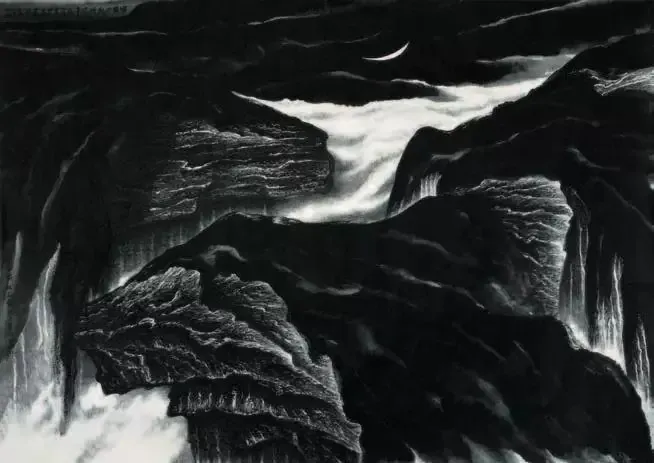
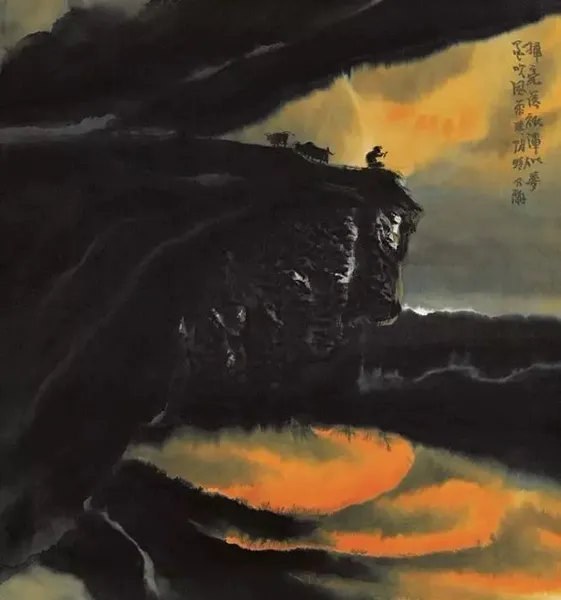
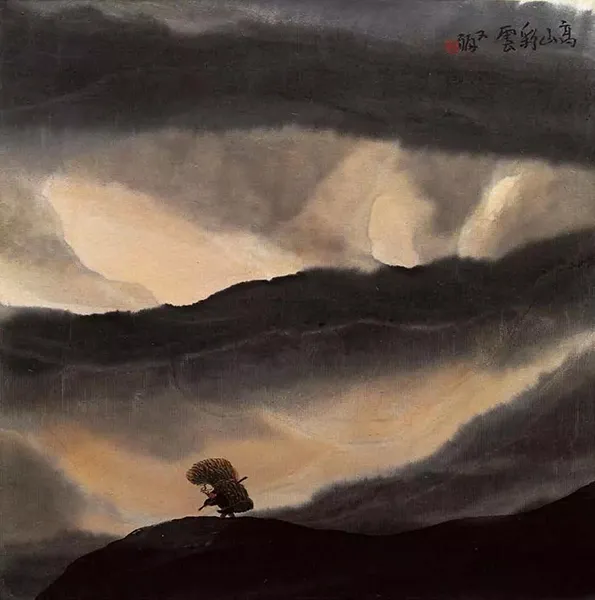
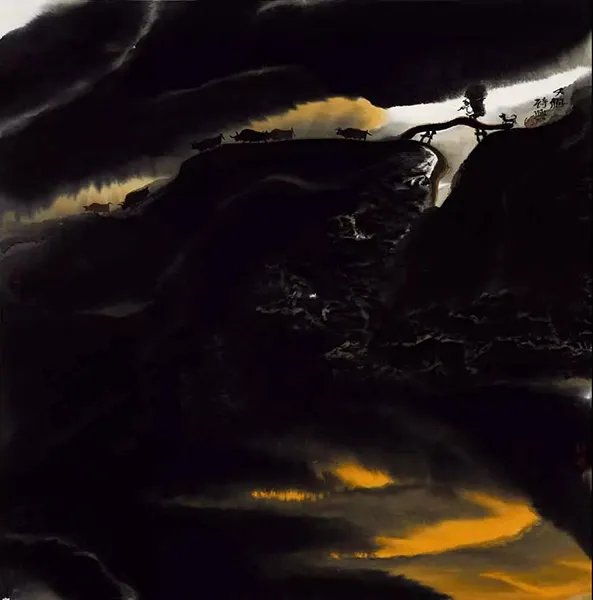
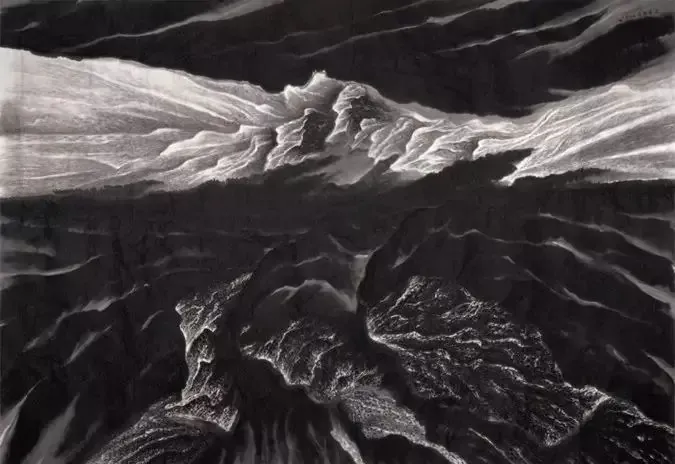

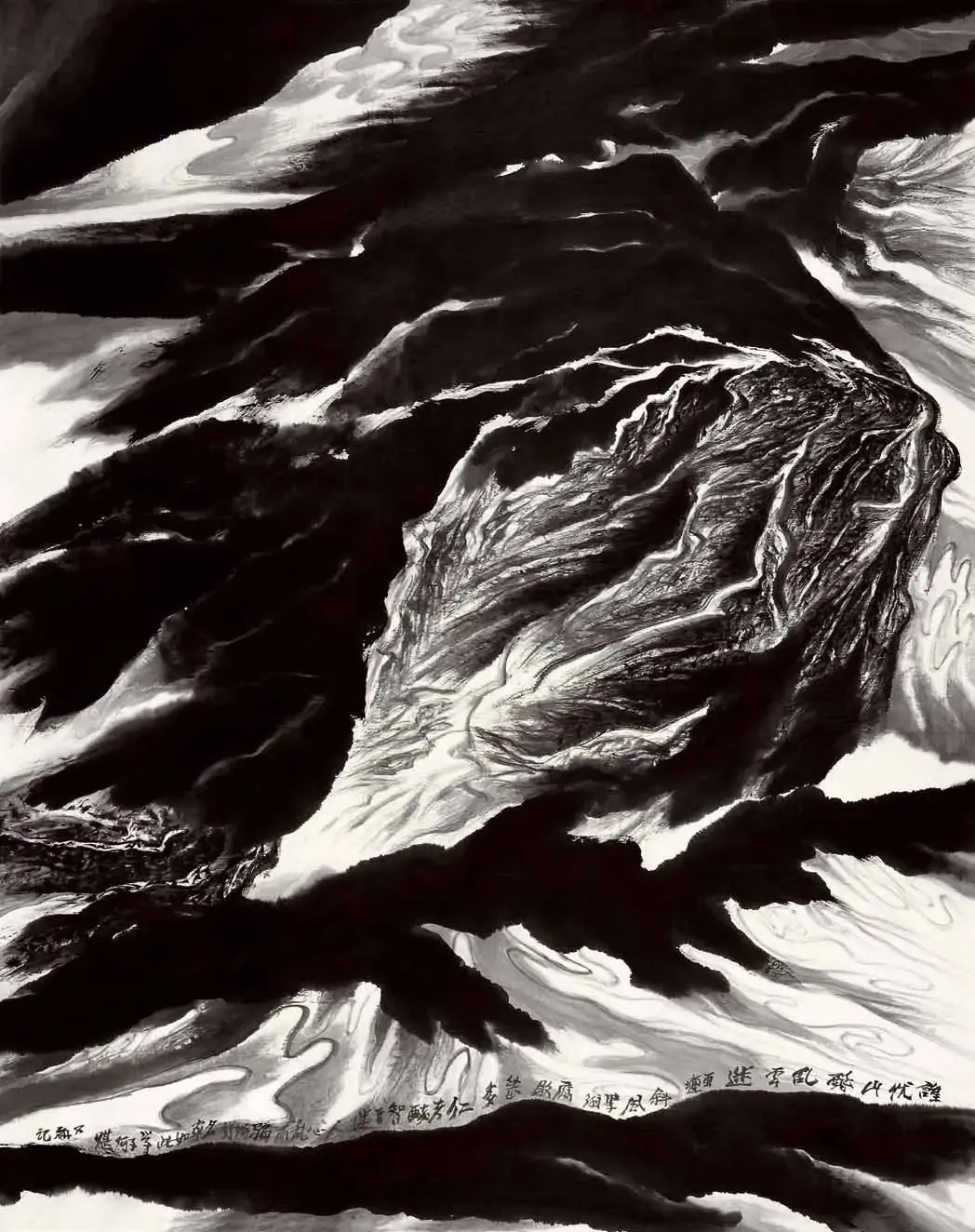

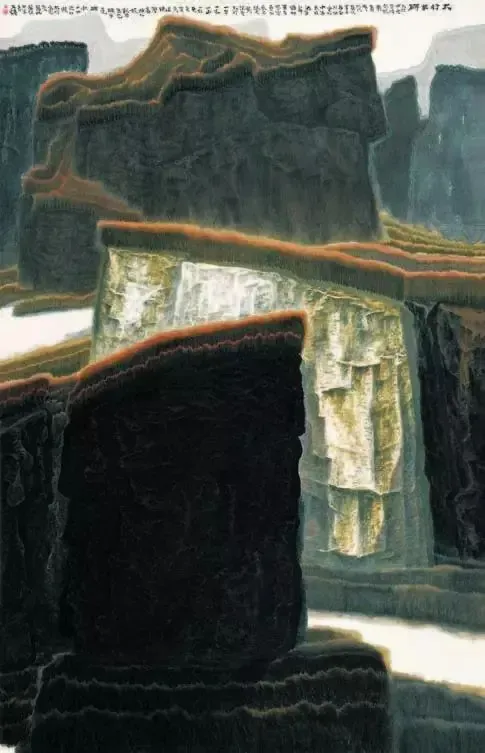

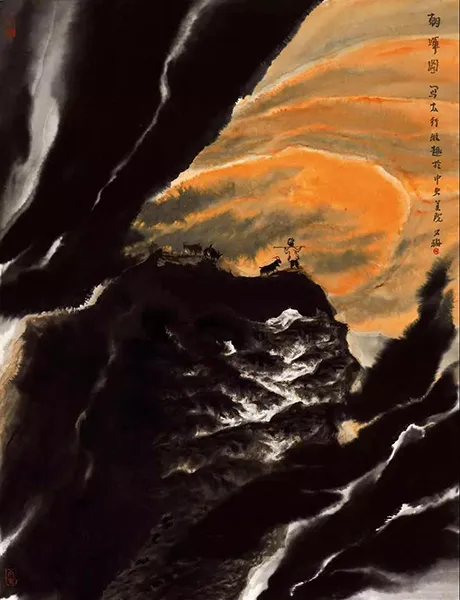

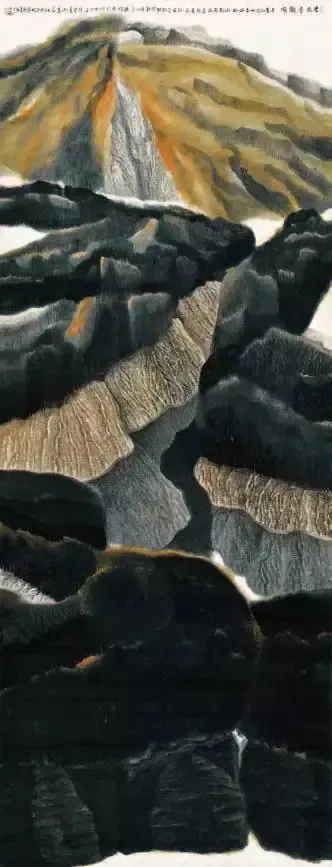


贾氏山水画,表现哲理精神,非自然真实景观,合天道与美规律。以独特山水画形式语言,表达现代哲学观念与审美思考。其山水画,于诗思与哲思直到,达时代新高度,诗化山水画,开拓审美精神新绿洲。贾氏山水,似山水,非山水,再观仍山水。得禅宗妙悟,兼现代抽象之美,超技法、形式、笔墨,达圣境,浑然天成。
Jia's landscape paintings convey philosophical spirit, not naturalistic scenes, but conforming to the laws of nature and beauty. Using a unique formal language of landscape painting, he expresses modern philosophical ideas and aesthetic considerations. His landscape paintings, achieving new heights in both poetic and philosophical realms, have opened a new spiritual oasis in the aesthetic domain.Jia's landscapes seem like landscapes, yet they are not; upon further viewing, they become landscapes again. They embody the insights of Zen Buddhism and the beauty of modern abstract art, transcending technique, form, and brushwork, reaching a divine and natural beauty.
或曰:画不似山水,构图非山水,山轮廓不见,设色深厚少灵动。宋元以来,山水画非实体山水,乃文人虚构精神世界。黄宾虹晚期,以大观小,笔墨之外,精神写意极致。
Critics may say: the paintings do not resemble landscapes, the compositions are not typical of landscapes, the mountain contours are unclear, and the coloring is deep but lacks agility. Since the Song and Yuan dynasties, landscape painting has not been about physical landscapes but about the spiritual world constructed by literati. Late works of Huang Binhong exemplify using the small to view the large, extending beyond brush and ink to reach the ultimate in spiritual expression.
贾氏画破空间格局,条状色块,具西方抽象感,大红大黑,视觉冲击力强,又有中国文人山水精神。外师造化中得心源,笔墨兼宋元山水博大雄奇,元人笔墨意趣。写心象,承李可染外化至内化,色彩冲击如狂风暴雨,细密生动如风暴后微风,温存诗意。
abstract art, using bold reds and blacks for strong visual impact, yet retaining the spirit of Chinese literati landscapes. Following nature to attain the essence, his brushwork encompasses the grandeur of Song and Yuan landscapes and the brush interest of Yuan painters. He extends Li Keran's externalization of nature to internalization, with color impacts like a storm, while fine details are lively, resembling a gentle breeze after the storm, warm and poetic.
不同阶段,贾氏尝试诸般美学,空间破碎再糅合,虽非立体抽象,实具解构之意。太行雄浑冷峻,笔端成符,牛羊人物巧融其中,皆生动如真。在大色块雄浑背景下,精神洗礼,画面和谐,神性充盈。贾氏归于山林,悟“真我”之境。
In different phases, Jia has explored various aesthetics, breaking and recombining space, with a spirit of deconstruction despite not being abstract like Cubism. The grandeur and coldness of the Taihang Mountains, the symbolic figures, the integration of cattle and sheep, all bring life to his work. Against the background of grand color blocks, a spiritual cleansing occurs, harmonizing the picture, filled with divine power. Jia returns to the mountains, perceiving the realm of the "true self."
或曰:构图千篇一律,意难明,传统山水精神何在?见仁见智,笔墨暗里,构图破传统,重构山水人物,自由融入,不用传统尺度衡量,感受美冲击与心灵净化,足矣。
贾氏静观,精神升华,臻“从心所欲不逾矩”之境。其艺倡高尚精神,陶冶情操,导人弃恶从善,济世造福。其作品形神并茂,光华四射,恒久不灭。
Critics may argue: the compositions are repetitive, the meanings obscure, and where is the traditional spirit of landscape painting? Opinions vary, but in my view, the essence lies within. By breaking traditional composition, reconstructing landscapes and figures, freely integrating elements, one should not measure by traditional standards but simply experience the impact of beauty and the purification of the soul—this suffices.
Through quiet observation, Jia achieves spiritual elevation, reaching the state of "following the heart's desires without overstepping the bounds." His art promotes noble spirit, cultivates character, guides people to abandon evil and embrace good, benefiting society. His works, both in form and spirit, shine brightly and endure forever.
责任编辑:苗君
